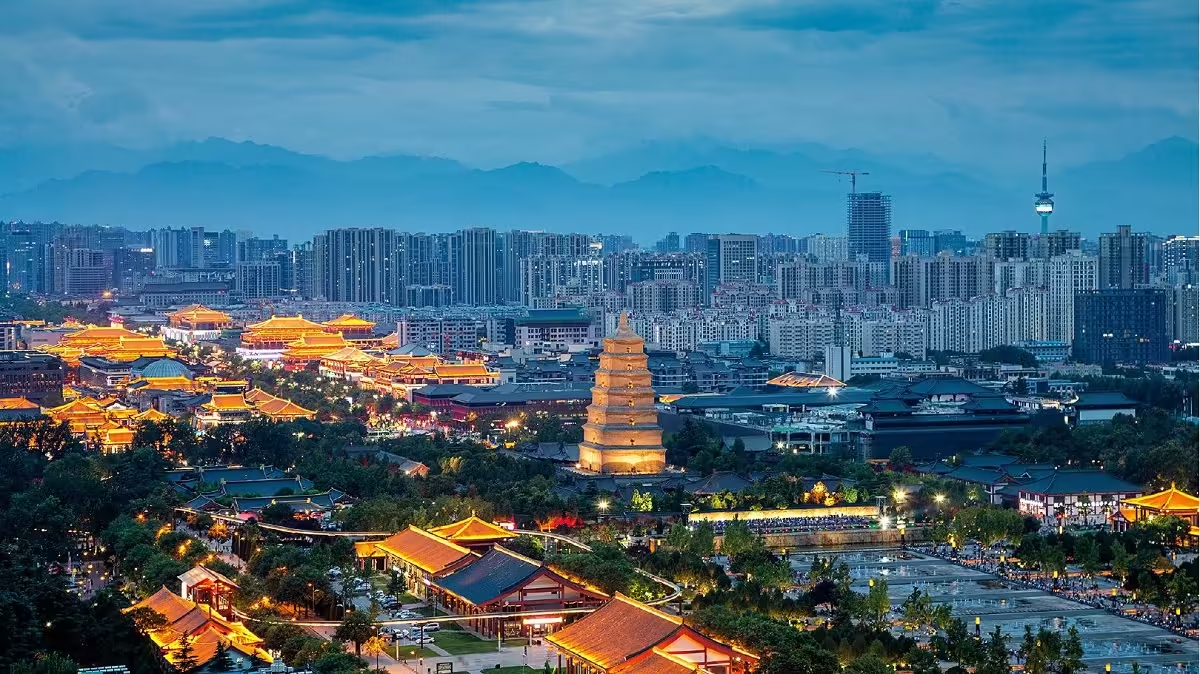Xi’an, one of the most historically significant cities in China, stands as a living testament to the rich cultural heritage and ancient splendor of the Chinese civilization. Known as a world-famous cultural city, Xi’an preserves the complete appearance of an ancient capital, where history and tradition blend seamlessly with the modern world. From the revered Da Yan Pagoda, where Buddhist scriptures are stored, to the imperial splendor of the Daming Palace, Xi’an is a city where the echoes of the past continue to resonate in the present.
The Ancient City Wall: Guardian of Xi’an
The most iconic structure in Xi’an is its ancient city wall, which has stood as the city’s guardian for centuries. The wall encircles the old city, maintaining its historical integrity and offering a tangible connection to the past. These weathered walls, bearing the marks of time, serve as the best witnesses to Xi’an’s long and storied history. Cycling along the city wall provides a panoramic view of Xi’an, with its towering skyscrapers juxtaposed against the ancient rivers of Jing and Wei, symbolizing the deep layers of history buried beneath the modern landscape. As the sun sets and the moon rises, the city wall remains a steadfast symbol of Xi’an’s enduring legacy.
The Bell Tower: Xi’an’s Timeless Symbol
Standing tall in the heart of Xi’an for over 600 years, the Bell Tower is another emblem of the city’s rich history. It serves as a symbol of Xi’an, chronicling the city’s transformations over the centuries. The Bell Tower, with its ancient architecture, complements the nearby Drum Tower, creating a harmonious balance between the past and present. Together, these towers resonate with the rhythms of history, marking the passage of time in this ancient city. The Bell Tower, in particular, is a revered symbol of Xi’an, standing as a testament to the city’s resilience and continuity.
Shuyuanmen: A Glimpse into Xi’an’s Scholarly Past
A short walk south from the Bell Tower brings you to Shuyuanmen, an ancient cultural street steeped in scholarly tradition. The street is marked by a towering archway inscribed with the golden characters “Shuyuanmen,” inviting visitors into a world of classic Chinese architecture. The street is lined with buildings that evoke the elegance of ancient times, with their black plaques and gold lettering, creating an atmosphere of scholarly refinement. As you wander through the narrow passageways and admire the carved railings and lattice windows, you can almost feel the presence of the scholars and literati who once frequented this area. Shuyuanmen is a place where the intellectual spirit of ancient China is still alive, offering a glimpse into the cultural richness of Xi’an.
The Western Market: A Hub of International Trade
Xi’an’s historical significance as a hub of international trade is exemplified by the Western Market, which was once home to a vibrant community of foreign merchants. These traders, hailing from Central Asia, Persia (modern-day Iran), and Arabia, came to Chang’an (the ancient name of Xi’an) via the Silk Road, bringing with them spices, medicines, and other exotic goods. In return, they took back with them Chinese silk, jewelry, and porcelain. The Western Market was a bustling center of commerce, where the goods and cultures of East and West met and mingled. This cultural exchange was a key factor in Xi’an’s prosperity and its reputation as a global city.
The Silk Road and Xi’an’s Modern Revival
Today, Xi’an is experiencing a resurgence in its historical role as a key node in international trade, thanks to the Belt and Road Initiative. This modern-day Silk Road has injected new vitality into Xi’an, making it an important transportation hub connecting China with countries along the Belt and Road route. The Chang’an Express, an international freight train loaded with goods, departs from Xi’an and heads west, solving the logistical challenges that have plagued the Eurasian Land Bridge for more than two decades. The rapid movement of goods along this route has brought Xi’an closer to Central Asia, heralding a new era of economic and cultural exchange that echoes the city’s ancient past.
Da Yan Pagoda: A Symbol of Ancient Wisdom
The Da Yan Pagoda, or Giant Wild Goose Pagoda, is another symbol of Xi’an’s timeless charm. This pagoda, built in the traditional Chinese style, is a brick structure in the shape of a square cone. The pagoda’s interior features a spiral staircase leading to the top, where visitors can enjoy a panoramic view of the city. Each side of the pagoda’s base has stone doors adorned with exquisite carvings of Buddha, believed to be the work of the famous Tang Dynasty painter Yan Liben. Standing atop the pagoda, one can take in the sweeping vistas of Chang’an, imagining the city as it was during its days of glory.
A Thousand-Year-Old City: The Essence of Xi’an
Xi’an is a city where the weight of history is palpable, where every stone and structure seems to tell a story of the past. The city’s ancient architecture, its cultural relics, and its enduring traditions create a unique atmosphere that is both majestic and contemplative. Xi’an’s charm lies in its ability to transport visitors back in time, allowing them to experience the grandeur of ancient China while also embracing the vibrancy of the present. This ancient capital, with its profound history and enduring spirit, leaves an indelible impression on all who visit, offering a journey through time that is both fascinating and unforgettable.

